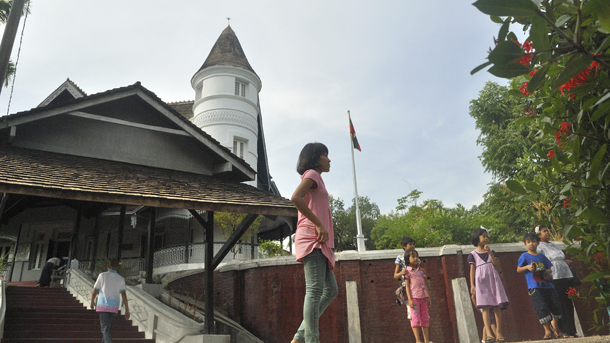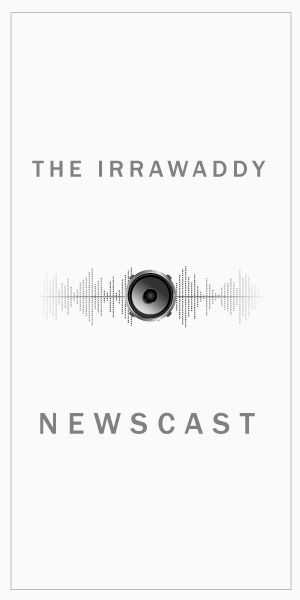RANGOON—After parking his car outside the hill-top villa in a leafy neighborhood just a few hundred meters from the Shwedagon Pagoda, Zaw Htet Aung tells his son, “this is where General Aung San used to live.” His wife nods in agreement.
The couple chaperoned their boy to this two-storied colonial-style wooden house, namely the Bogyoke (General) Aung San Museum, for their only child’s benefit.
“He has seen Bogyoke in pictures,” said eight-year-old Tet Htut Aung’s father. “That’s why we’ve brought him here to have some more ideas about Aung San.”
After being closed for five years for large-scale maintenance, the former home of Burma’s national hero and his family has now reopened to the public—providing a unique glimpse into his private life.
Thaung Win, the director of the Rangoon National Museum and administrator of the Bogyoke Aung San Museum, told The Irrawaddy that the 91-year-old building reopened to the public on March 24 after renovations to strengthen the retaining walls as well as repairs to the roof, walkways and stairs.
“We want it to be one of the main information centers on Bogyoke Aung San as well as providing a window for young people to understand who he was and how he lived,” he said.
Aung San, the father of Burmese democracy icon Aung San Suu Kyi, is still highly respected as the hero of Burmese independence for his efforts in bringing about the end of British colonial rule.
“Bogyoke” and his family lived in the villa on lease from a Chinese couple from 1945 until he was gunned down in a 1947 conspiracy masterminded by his political rival U Saw. Aung San was just 32 years old.
After her husband’s assassination, Khin Kyi kept raising their three children—Aung San Oo, Aung San Lin and Aung San Suu Kyi—in the house until 1953 when Aung San Lin drowned in the compound’s pool.
Following the death of her second oldest son, Khin Kyi moved her family to the same colonial-era mansion by the shores of Inya Lake on University Avenue where Suu Kyi lives to this day.
The Burmese government bought the former residence for 30,000 kyats (US $37.5 at the time) in 1948 and it was converted into the Bogyoke Aung San Museum in 1962, according to an article published in The Monitor weekly journal.
But the museum was temporarily closed between 1999 and 2007 for refurbishment and only reopened each year on July 19, the commemorative day of Aung San’s assassination, during this period.
Until last week, according to official records, the museum has seen 1,419 visitors including 140 foreigners. “A museum is not a profit-making service,” said Thaung Win. “So we have fixed the entrance fee at a reasonable price [300 kyat] hoping to encourage everyone to visit.”
The museum boasts a host of Aung San’s personal belongings ranging from a British-built black Wolseley motor vehicle to an overcoat given to him by the first Indian Prime Minister Jawaharlal Nehru during a trip to England in the early 1940s.
A collection of 240 books on a variety of subjects—from applied mechanics and air defense to political economy and selected short stories by D.H. Lawrence—may be a source of interest for literature fans.
Downstairs features pictures and paintings of Aung San and his family, while the special meeting room upstairs is decorated with extracts from some of his speeches—including the explanatory guideline relating to the 1947 constitutional law which states “no constitution in the world is perfect.”
This hero’s residence has an aura of simplicity and is devoid of any trace of ostentation—the only embellishments are basic requirements for anyone to enjoy a happy family life.
Being curious about the independence icon’s private quarters, Wai Zin, 23, visited the museum for the first time last week. “Now I believe the Bogyoke had a very simple lifestyle,” said the business management graduate after touring the museum.
The lack of luxuries demonstrates that, despite his power, Aung San never sought to use his position to feather his own nest—adding to the sense of reverence which accompanies his name all throughout Burma. “Some members of the government today should take him as a role-model,” said May Moe, 24, an English major graduate from Rangoon.
Even though Aung San remains highly regarded as the national hero who founded the modern Burmese Army, there was a time when his reputation was stifled by attempts to wipe him from people’s memories.
After the rise of his daughter’s influence in the Burmese pro-democracy movement following the 1988 students’ uprising, everything related to Aung San was pushed into the background by the then-military dictatorship. His portrait at government schools and offices were replaced with former junta supremo Snr-Gen Than Shwe.
The Lion, the insignia of the ruling Union Solidarity and Development Association, took the place of Aung San’s image on Burmese banknotes from the 1990s. July 19, known as Martyrs Day in the Burmese calendar, was a muted celebration until last year. Elementary school text books only provided a brief description of Aung San and a 10-stanza poem as his biography.
“Thanks to the former military government’s ban, Burma’s younger generation today has little or no idea who Aung San is,” said Zaw Htet Aung. “Thank God there are people who are selling Bogyoke’s pictures. Were it not for them, we wouldn’t have anything to show our children what Aung San looks like.”
Zaw Htet Aung is hopeful that the museum will help promote awareness amongst the next generation regarding Aung San and his message. “We need young people with ‘Aung San’s spirit’ who are honest, unselfish and work hard for the national interest—especially these days when our country is in a transitional period,” he said.
“I don’t want to be a soldier like Bogyoke. I’m afraid of guns,” said Tet Htut Aung after visiting the museum. “But I want to be a doctor, and I want to be an honest person like Bogyoke too.”
Bogyoke Aung San Museum is situated on a 2.5-acre plot of land in Bahan Township, near Kandawgyi Lake. It is open Wednesday through Sunday from 10 am to 4 pm, except on public holidays. Admission costs 300 kyats (US $0.40) for adults—both Burmese and foreigners—and 100 kyats ($0.10) for children under 12, but is free for students.















